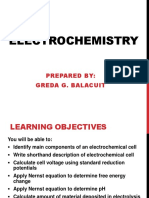Chemistry
Uploaded by
Hey UmmmChemistry
Uploaded by
Hey UmmmContent overview
Candidates study the following topics:
1 States of matter
2 Atoms, elements and compounds
3 Stoichiometry
4 Electrochemistry
5 Chemical energetics
6 Chemical reactions
7 Acids, bases and salts
8 The Periodic Table
9 Metals
10 Chemistry of the environment
11 Organic chemistry
12 Experimental techniques and chemical analysis
Key Concepts in Electrochemistry
1. Redox Reactions:
o Electrochemistry is based on oxidation-reduction (redox) reactions, where:
Oxidation is the loss of electrons.
Reduction is the gain of electrons.
o Example: Zn (s)→Zn2++2e− (oxidation)\text{Zn (s)} \rightarrow \text{Zn}^{2+}
+ 2\text{e}^- \, (\text{oxidation})Zn (s)→Zn2++2e−(oxidation) Cu2+
+2e−→Cu (s) (reduction)\text{Cu}^{2+} + 2\text{e}^- \rightarrow \text{Cu
(s)} \, (\text{reduction})Cu2++2e−→Cu (s)(reduction)
2. Electrochemical Cells:
o Devices that convert chemical energy into electrical energy or vice versa.
o Two main types:
Galvanic (Voltaic) Cells: Generate electricity from spontaneous redox
reactions.
Electrolytic Cells: Use electrical energy to drive non-spontaneous
reactions.
3. Electrodes:
o Anode: The electrode where oxidation occurs.
o Cathode: The electrode where reduction occurs.
o In a galvanic cell, the anode is negative, and the cathode is positive. In an
electrolytic cell, the polarity is reversed.
4. Salt Bridge:
o A device in a galvanic cell that maintains electrical neutrality by allowing the
flow of ions between the two half-cells.
Types of Electrochemical Cells
1. Galvanic (Voltaic) Cells:
o Example: Daniell Cell.
Reaction: Zinc reacts with copper sulfate to produce electricity.
Components:
Anode: Zinc metal (Zn\text{Zn}Zn).
Cathode: Copper metal (Cu\text{Cu}Cu).
Electrolytes: Solutions of zinc sulfate and copper sulfate.
Overall Reaction: Zn (s)+Cu2+→Zn2++Cu (s)\text{Zn (s)} + \
text{Cu}^{2+} \rightarrow \text{Zn}^{2+} + \text{Cu (s)}Zn (s)
+Cu2+→Zn2++Cu (s)
2. Electrolytic Cells:
o Example: Electrolysis of water.
Reaction: Decomposition of water into hydrogen and oxygen gases.
Components:
Anode: Oxygen gas evolves (2H2O→O2+4H++4e−\text{2H}_2\
text{O} \rightarrow \text{O}_2 + 4\text{H}^+ + 4\text{e}^-2H2
O→O2+4H++4e−).
Cathode: Hydrogen gas evolves (2H2O+2e−→H2+2OH−\
text{2H}_2\text{O} + 2\text{e}^- \rightarrow \text{H}_2 + 2\
text{OH}^-2H2O+2e−→H2+2OH−).
Key Terms and Quantities
1. Cell Potential (E∘E^\circE∘):
o The voltage produced by an electrochemical cell, calculated using the Nernst
equation.
o Standard Electrode Potential (E∘E^\circE∘): Measured under standard conditions
(25°C, 1 atm, 1 M solutions).
2. Faraday’s Laws of Electrolysis:
o First Law: The mass of a substance deposited or dissolved at an electrode is
proportional to the electric charge passed.
o Second Law: When the same charge passes through different electrolytes, the
masses of substances deposited are proportional to their equivalent weights.
3. Nernst Equation:
o Relates the cell potential to the concentrations of reactants and products:
E=E∘−RTnFlnQE = E^\circ - \frac{RT}{nF} \ln QE=E∘−nFRTlnQ Where:
EEE: Cell potential under non-standard conditions.
RRR: Gas constant.
TTT: Temperature in Kelvin.
nnn: Number of moles of electrons transferred.
FFF: Faraday constant (96485 C/mol96485 \, \text{C/mol}96485C/mol).
QQQ: Reaction quotient.
Applications of Electrochemistry
1. Batteries:
o Galvanic cells used to store and supply energy.
o Examples:
Primary Batteries: Non-rechargeable (e.g., alkaline batteries).
Secondary Batteries: Rechargeable (e.g., lithium-ion, lead-acid).
2. Fuel Cells:
o Convert chemical energy from fuels (like hydrogen) into electricity, emitting
water as a byproduct.
3. Electroplating:
o Coating a metal object with a thin layer of another metal for protection or
aesthetics.
4. Corrosion Prevention:
o Electrochemistry helps understand and prevent corrosion, such as rusting of iron.
5. Industrial Processes:
o Production of chemicals like chlorine and sodium hydroxide through electrolysis
of brine.
Real-World Example: Lithium-Ion Batteries
Widely used in electronics, electric vehicles, and renewable energy storage.
Components:
o Anode: Typically graphite.
o Cathode: Lithium metal oxide.
o Electrolyte: Lithium salts in an organic solvent.
Reaction:
o During discharge: Lithium ions move from anode to cathode.
o During charging: Lithium ions move back to the anode.
Importance of Electrochemistry
Electrochemistry bridges the gap between chemistry and electricity, enabling technological
advancements and sustainable solutions. From powering everyday devices to driving industrial
processes, its principles continue to shape the future of energy and materials science.
nnnnnnnnnnnnnnnnnnnnnnnnnn
You might also like
- Science Class X Sample Paper Test 08 For Board Exam 20240% (1)Science Class X Sample Paper Test 08 For Board Exam 20249 pages
- Class 12th Chemistry Electrochemistry PSEBNo ratings yetClass 12th Chemistry Electrochemistry PSEB6 pages
- Httpsecl-Lecture - Web.psi - Chpublicelc Skript 2023 PDFNo ratings yetHttpsecl-Lecture - Web.psi - Chpublicelc Skript 2023 PDF299 pages
- Exploring The Wonders of ElectrochemistryNo ratings yetExploring The Wonders of Electrochemistry11 pages
- Advanced_Electrochemistry_PPT_FYBtech__2_ (1)No ratings yetAdvanced_Electrochemistry_PPT_FYBtech__2_ (1)23 pages
- Electrochemistry_Investigatory_Project_Final (1)No ratings yetElectrochemistry_Investigatory_Project_Final (1)9 pages
- Chapter 15-4811-ElectroanalyticalmethodsNo ratings yetChapter 15-4811-Electroanalyticalmethods137 pages
- Electrochemical-Processes-for-1st-Year-EngineeringNo ratings yetElectrochemical-Processes-for-1st-Year-Engineering9 pages
- Baumgärtel H Electrochemistry A Guide For Newcomers Walter de GruyterNo ratings yetBaumgärtel H Electrochemistry A Guide For Newcomers Walter de Gruyter241 pages
- Chemistry for Mechanical Engineering - BookNo ratings yetChemistry for Mechanical Engineering - Book191 pages
- Module 2-Battery Technology--CHE1017(1)No ratings yetModule 2-Battery Technology--CHE1017(1)57 pages
- Lecture 1 - Introduction To ElectrochemistryNo ratings yetLecture 1 - Introduction To Electrochemistry39 pages
- Key Points Chemistry Electrochemistry (1)No ratings yetKey Points Chemistry Electrochemistry (1)2 pages
- Advanced Electrochemistry - PPT - FYBtechNo ratings yetAdvanced Electrochemistry - PPT - FYBtech26 pages
- Fundamentals of Electrochemistry: Electrical Measurements of Chemical ProcessesNo ratings yetFundamentals of Electrochemistry: Electrical Measurements of Chemical Processes27 pages
- Electrode potential and electrochemical cellsNo ratings yetElectrode potential and electrochemical cells3 pages
- Physc Sciences p2 Gr12 QP June 2022 EnglishNo ratings yetPhysc Sciences p2 Gr12 QP June 2022 English20 pages
- CHAPTER - 3 Preliminary and Primary Wastewater Treatment MethodsNo ratings yetCHAPTER - 3 Preliminary and Primary Wastewater Treatment Methods35 pages
- Magnetic Hydro Dynamic Power Generation Full Seminar Report100% (1)Magnetic Hydro Dynamic Power Generation Full Seminar Report9 pages
- Physical Science SHS 1.2 Stellar Evolution and The Formation of Heavier ElementsNo ratings yetPhysical Science SHS 1.2 Stellar Evolution and The Formation of Heavier Elements26 pages
- AWWA Standard For Granular Activated Carbon: AWWA B604-74 (First Edition)No ratings yetAWWA Standard For Granular Activated Carbon: AWWA B604-74 (First Edition)10 pages
- Special Sampling and Handling Requirements - SMEWW100% (1)Special Sampling and Handling Requirements - SMEWW4 pages
- Anomalous Reaction of Epichlorohydrin With Trimethylamine by D. M. BurnessNo ratings yetAnomalous Reaction of Epichlorohydrin With Trimethylamine by D. M. Burness3 pages
- June 2016 (v2) QP - Paper 2 CIE Chemistry A-LevelNo ratings yetJune 2016 (v2) QP - Paper 2 CIE Chemistry A-Level12 pages
- Soil Fertility AGR521: Soil Organic Matter ContentNo ratings yetSoil Fertility AGR521: Soil Organic Matter Content7 pages























































































































